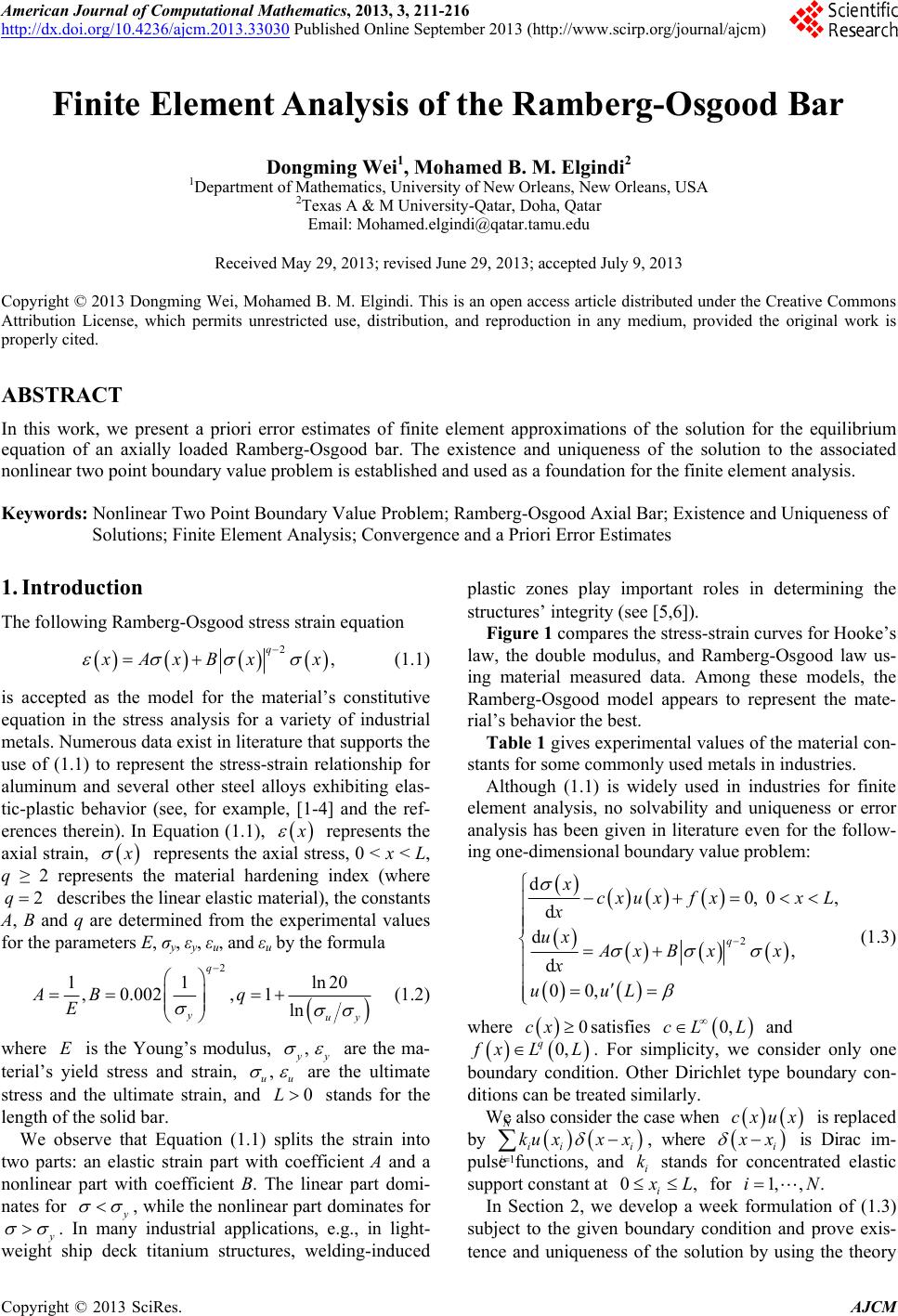 American Journal of Computational Mathematics, 2013, 3, 211-216 http://dx.doi.org/10.4236/ajcm.2013.33030 Published Online September 2013 (http://www.scirp.org/journal/ajcm) Finite Element Analysis of the Ramberg-Osgood Bar Dongming Wei1, Mohamed B. M. Elgindi2 1Department of Mathematics, University of New Orleans, New Orleans, USA 2Texas A & M University-Qatar, Doha, Qatar Email: Mohamed.elgindi@qatar.tamu.edu Received May 29, 2013; revised June 29, 2013; accepted July 9, 2013 Copyright © 2013 Dongming Wei, Mohamed B. M. Elgindi. This is an open access article distributed under the Creative Commons Attribution License, which permits unrestricted use, distribution, and reproduction in any medium, provided the original work is properly cited. ABSTRACT In this work, we present a priori error estimates of finite element approximations of the solution for the equilibrium equation of an axially loaded Ramberg-Osgood bar. The existence and uniqueness of the solution to the associated nonlinear two point boundary value problem is established and used as a foundation for the finite element analysis. Keywords: Nonlinear Two Point Boundary Value Problem; Ramberg-Osgood Axial Bar; Existence and Uniqueness of Solutions; Finite Element Analysis; Convergence and a Priori Error Estimates 1. Introduction The following Ramberg-Osgood stress strain equation 2, q Ax Bxx (1.1) is accepted as the model for the material’s constitutive equation in the stress analysis for a variety of industrial metals. Numerous data exist in literature that supports the use of (1.1) to represent the stress-strain relationship for aluminum and several other steel alloys exhibiting elas- tic-plastic behavior (see, for example, [1-4] and the ref- erences therein). In Equation (1.1), represents the axial strain, represents the axial stress, 0 < x < L, q ≥ 2 represents the material hardening index (where describes the linear elastic material), the constants A, B and q are determined from the experimental values for the parameters E, σy, εy, εu, and εu by the formula 2q 2 11 ln ,0.002 ,1 ln q yuy AB q E 20 (1.2) where is the Young’s modulus, E, y u are the ma- terial’s yield stress and strain, , u 0L are the ultimate stress and the ultimate strain, and stands for the length of the solid bar. We observe that Equation (1.1) splits the strain into two parts: an elastic strain part with coefficient A and a nonlinear part with coefficient B. The linear part domi- nates for , while the nonlinear part dominates for . In many industrial applications, e.g., in light- weight ship deck titanium structures, welding-induced plastic zones play important roles in determining the structures’ integrity (see [5,6]). Figure 1 compares the stress-strain curves for Hooke’s law, the double modulus, and Ramberg-Osgood law us- ing material measured data. Among these models, the Ramberg-Osgood model appears to represent the mate- rial’s behavior the best. Table 1 gives experimental values of the material con- stants for some commonly used metals in industries. Although (1.1) is widely used in industries for finite element analysis, no solvability and uniqueness or error analysis has been given in literature even for the follow- ing one-dimensional boundary value problem: 2 d0, 0, d d, d 00, q xcxuxf xxL x ux Ax Bxx x uuL (1.3) where 0cxsatisfies and 0,cL L 0, q L Lfx . For simplicity, we consider only one boundary condition. Other Dirichlet type boundary con- ditions can be treated similarly. We also consider the case when is replaced by 1i , where cxux i N ii i ku xxx x is Dirac im- pulse functions, and stands for concentrated elastic support constant at i k 0, i L for 1, ,iN. In Section 2, we develop a week formulation of (1.3) subject to the given boundary condition and prove exis- tence and uniqueness of the solution by using the theory C opyright © 2013 SciRes. AJCM  D. WEI, M. B. M. ELGINDI 212 0 5 10 15 20 25 30 35 40 45 50 00.01 0.02 0.03 0.04 0.050.060.070.08 0.09 STRESS(ksi) STRAIN(in/in) FourdifferentStress/Strainmodels,comparedwithmeasureddata MeasuredData‐ Material1 MeasuredData‐ Material2 Hooke'sLaw,Material1 Hooke'sLaw,Material2 Ramberg‐Osgood,Material1 Ramberg‐Osgood,Material2 Reduce dModulusModel‐ Material1 Reduce dModulusModel‐ Material2 Figure 1. Ramburg-Osgood curves. Table 1. Constants for Ramburg-Osgood materials. Material A B q − 1 Inconel 718 3.33e−05 4.42e−71 32.00 5083 Aluminum 9.80e−05 2.50e−23 13.11 6061T6 Aluminum 1.00e−04 1.35e−58 34.44 304 Stainless Steel 3.57e−05 3.44e−13 6.32 304 L StainlessSteel 3.57e−05 2.24e−15 7.36 of perturbed convex variational problems in Sobolev spaces (see [7] for details.) We also prove that the solu- tion is bounded in certain Sobolev norms. In Section 3, we derive an error estimates for the semi-discrete error between the week solution and the Galerkin’s finite ele- ment solution of (1.3) for the standard conformal finite elements. The results of this section are based on the re- sults in Section 2. We believe that the results established in these sections are novel and preliminary. 2. Existence and Uniqueness of Solutions Let and be the standard Sobo- 1, 0, p W lev spaces, where . 1 q pq Define 2q AB , where 0,0, and 2.AB q Observe that the mapping is one-to-one; how- ever, its inverse cannot be written explicitly. Since u , Equation (1.3) can be rewritten as: 1 d() , 0 d , 00, xcxuxf xxL x uu uL (2.2) Define the following space of admissible functions as 1, 0,0 0,. p VuW LuuL (2.3) The weak formulation of (2.2) can then be written as Problem I: Find uV , such that 11 0 000 ddd0, LLl p uvxcuvxfvxvWL , . (2.4) L L 1, 00, p WLet us define the operator: Copyright © 2013 SciRes. AJCM 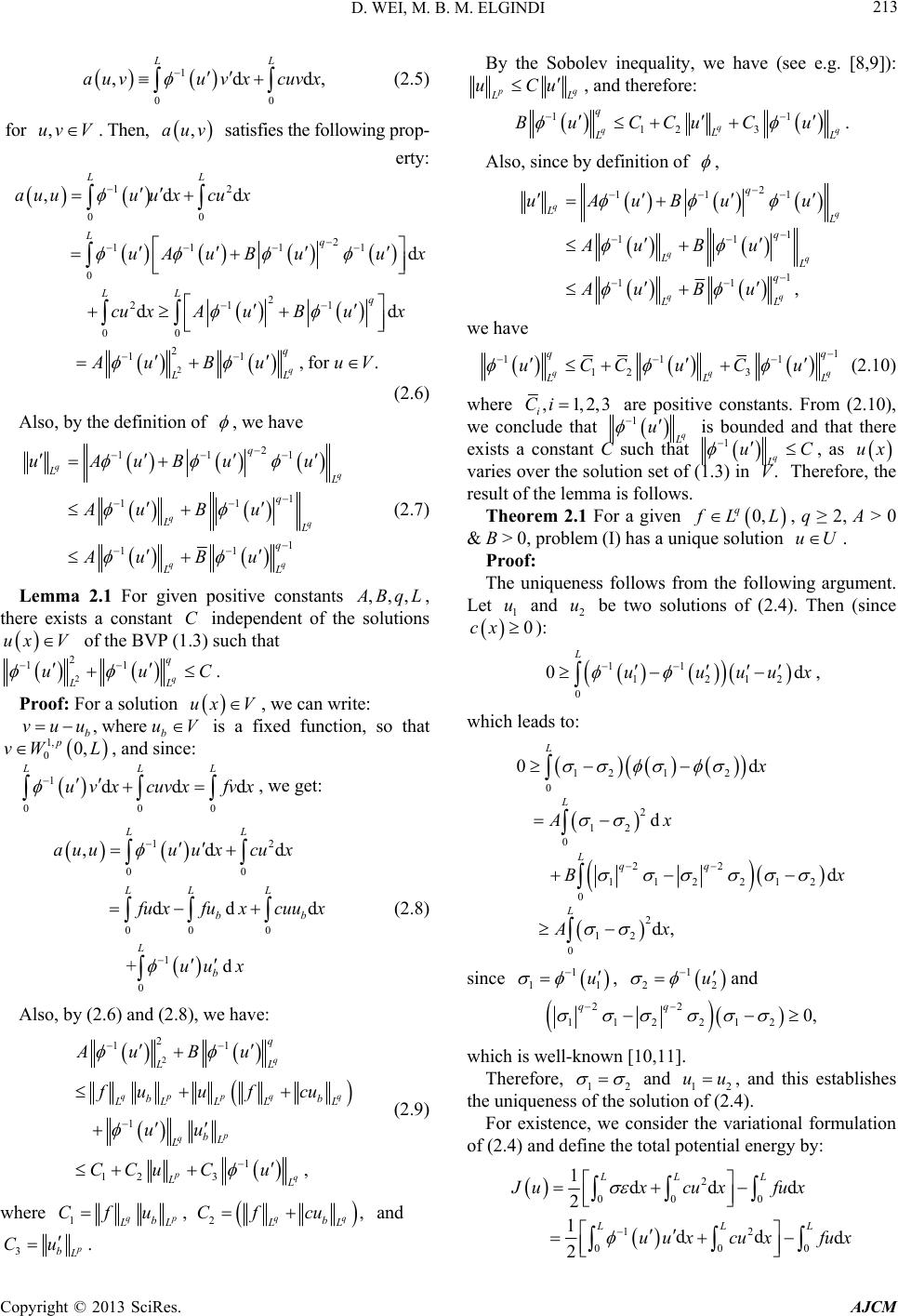 D. WEI, M. B. M. ELGINDI 213 1 00 ,d LL auvuv xcuvx d, (2.5) for . Then, satisfies the following prop- erty: ,uv V ,auv 2 00 11 12 2 1 1 2 21 1 00 2 11 ,dd d dd ,for. q LL q LL q q LL uu xcux uAu Buux cu xAuBux Au BuuV 0 L auu (2.6) Also, by the definition of , we have 2 111 1 11 1 11 qq qq qq q L q LL q LL uAuBuu AuB u Au Bu (2.7) Lemma 2.1 For given positive constants ,,, Bq L, there exists a constant independent of the solutions of the BVP (1.3) such that C ux V 2 2 11 q q LL uuC . Proof: For a solution ux V , we can write: , where bb vuuu 1, 00, p vW L LL V is a fixed function, so that , and since: 1 00 dduvxcuvxfvx 0 d L d d b , we get: 12 00 00 0 1 0 ,d dd +d LL LL L b L b auuuu xcux uxfuxcuu x uu x (2.8) Also, by (2.6) and (2.8), we have: 2 2 11 1 1 12 3, q qpq p p q pq q LL b LLLL bL L LL Au Bu fuu fcu uu CCu Cu q b L (2.9) where 12 ,, qq pq bb LLLL CfuC fcu and 3 b Cu . By the Sobolev inequality, we have (see e.g. [8,9]): q L uCu , and therefore: 11 12 3. q qq q L L BuCCuC u Also, since by definition of , 2 111 1 11 1 11 , qq qq qq q L q LL q LL uAuBuu AuB u Au Bu we have 1 11 12 3 qq qq 1 q LL uCCuCu (2.10) where ,1,2,3 i Ci are positive constants. From (2.10), we conclude that 1 q u is bounded and that there exists a constant C such that 1 q L uC , as ux varies over the solution set of (1.3) in Therefore, the result of the lemma is follows. .V Theorem 2.1 For a given , q ≥ 2, A > 0 & B > 0, problem (I) has a unique solution . 0, q fL L uU Proof: The uniqueness follows from the following argument. Let and be two solutions of (2.4). Then (since 1 u2 u 0cx ): 11 1212 0 0duuuu L x, which leads to: 12 12 0 2 12 0 22 112 212 0 2 12 0 0d d d d, L L Lqq L x Ax Bx Ax since 1 11 u , and 1 22 u 22qq 112 212 0, which is well-known [10,11]. Therefore, 12 and 12 u, and this establishes the uniqueness of the solution of (2.4). u For existence, we consider the variational formulation of (2.4) and define the total potential energy by: 2 00 0 12 00 1ddd 2 1dd 2 LL L LL Juxcu xfux uuxcu xfux 0 d L Copyright © 2013 SciRes. AJCM 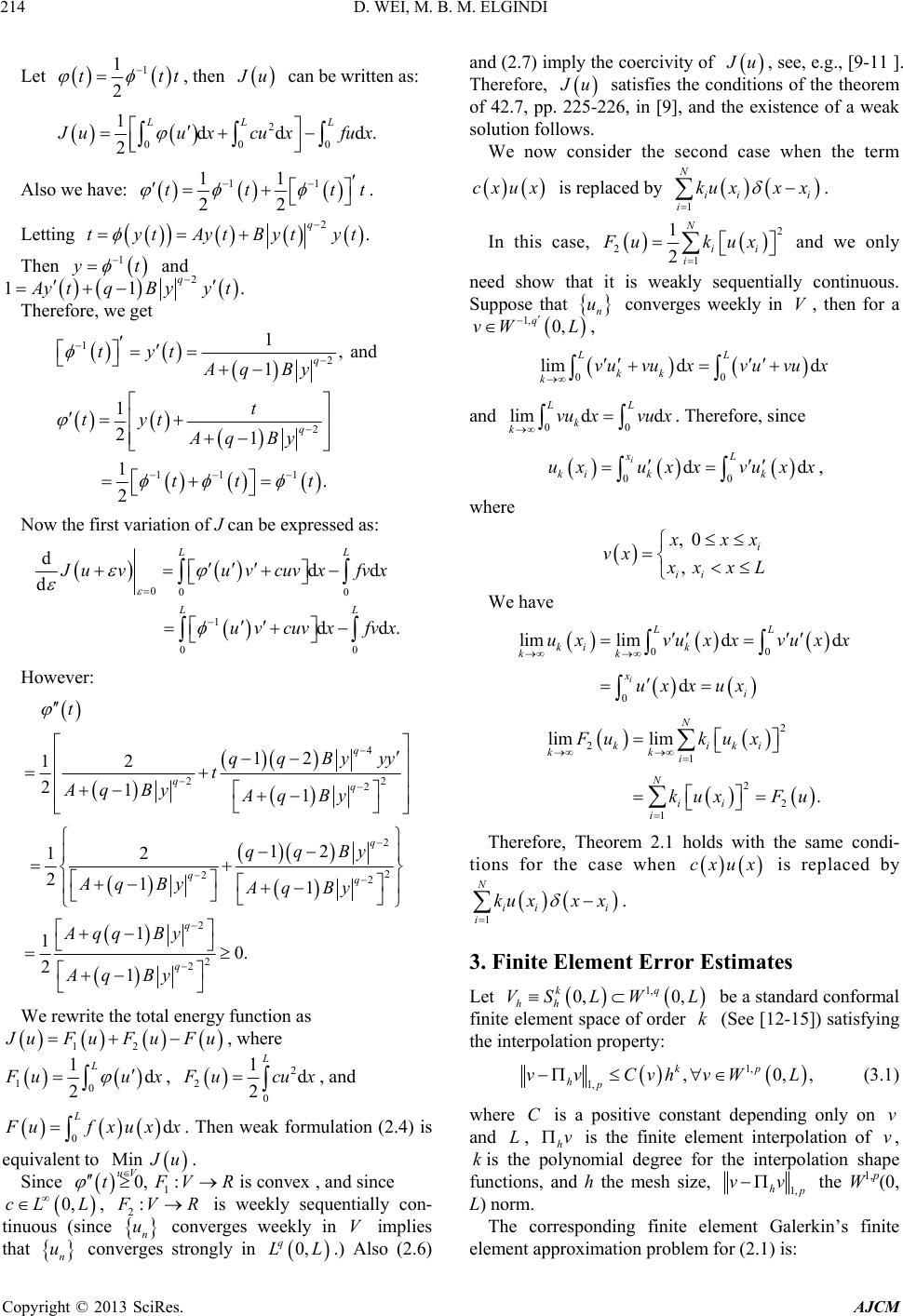 D. WEI, M. B. M. ELGINDI 214 Let 1 1 2 tt t , then u can be written as: 2 000 1dd 2 LLL d. uuxcux fux Also we have: 11 11 22 tt t t . Letting 2. q tytAytBytyt Then and 1 y t 2 11. q yt q By yt Therefore, we get 1 2 2 11 1 1, and 1 1 21 1. 2 q q tyt Aq By t tyt Aq By tt t Now the first variation of J can be expressed as: 00 1 00 ddd d dd LL L 0 . L uvuvcuvx fvx uvcuvxfvx However: 4 22 2 2 2 22 2 2 2 12 12 211 12 12 211 1 10. 21 q qq q qq q q t qqByyy t Aq ByAqBy qqBy Aq ByAqBy Aqq By Aq By We rewrite the total energy function as 12 uFuFuFu, where 10 1d 2 L uu x , 2 2 0 1d 2 L ucux , and 0d L ufxuxx. Then weak formulation (2.4) is equivalent to Min uV u 1 0, :tF . Since , and since , is convexVR 0, L2:cL VR n u 0, q L is weekly sequentially con- tinuous (since converges weekly in implies that converges strongly in .) Also (2.6) and (2.7) imply the coercivity of V n uL u, see, e.g., [9-11 ]. Therefore, u satisfies the conditions of the theorem of 42.7, pp. 225-226, in [9], and the existence of a weak solution follows. We now consider the second case when the term cxux is replaced by . ii x 1 N i i kux x In this case, i ux 2 2 1 1 2 N i i Fu k and we only need show that it is weakly sequentially continuous. Suppose that n u converges weekly in V, then for a 0, L mvu 0 d L k vu x ki ux 1, q vW , lid d kk kvuxvux 00 LL vu xL vu i and . Therefore, since 0 lim d L kvu x 00 dd i k k uxx xx , where , 0 , ii xx vx xxL 00 d LL i xx ux 2 ii u x x ux We have ki ux 2 lim Fu x x 0 lim limd d i k kk x vu vuxx ux x 2 1 2 1 lim . N kiki kk i N i k ku Fu Therefore, Theorem 2.1 holds with the same condi- tions for the case when is replaced by cx 1 N iii i ku x . 3. Finite Element Error Estimates Let 1, 0, q VS LWL k 0, k hh be a standard conformal finite element space of order (See [12-15]) satisfying the interpolation property: 1, 0,, kp hp vv CvhL 1, ,vW (3.1) where is a positive constant depending only on and , h Cv Lv is the finite element interpolation of , is the polynomial degree for the interpolation shape functions, and h the mesh size, v k 1, h vv the W1,p(0, L) norm. The corresponding finite element Galerkin’s finite element approximation problem for (2.1) is: Copyright © 2013 SciRes. AJCM 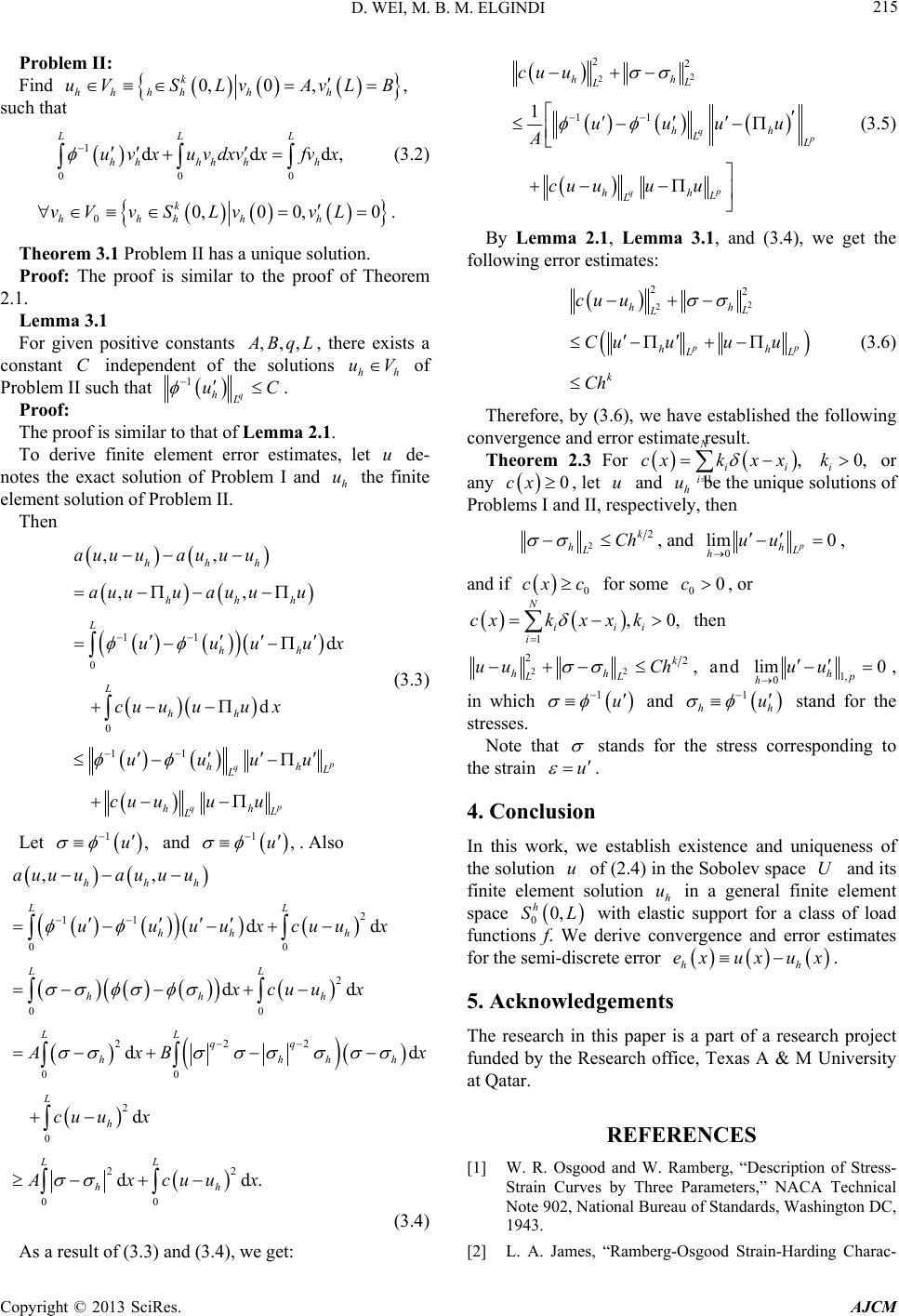 D. WEI, M. B. M. ELGINDI 215 Problem II: Find 0,0 ,, k hhhhhh uVSLvAvL B such that 1 000 dd LLL hhhhhh uvx uvdxvxfvx d, (3.2) 00,00,0 k hhhhh vVvSLvvL . Theorem 3.1 Problem II has a unique solution. Proof: The proof is similar to the proof of Theorem 2.1. Lemma 3.1 For given positive constants ,,, Bq L , there exists a constant independent of the solutions Ch uV h of Problem II such that 1 q uC hL . Proof: The proof is similar to that of Lemma 2.1. To derive finite element error estimates, let de- notes the exact solution of Problem I and the finite element solution of Problem II. u h u Then 11 0 0 11 ,, ,, d d q p q hhh hhh L hh L hh hh L L hh L L auuu auuu auuuau uu uuuu cu uuux uuuu cu uuu x (3.3) Let and . Also 1,u 1,u 2 11 00 2 00 22 2 00 2 0 2 2 00 ,, dd dd d d dd. hhh LL hh h LL hhh LL q q hhh L h LL hh auuuauu u uuuuxcuux xcuux d h xB x cu ux Axcuux (3.4) As a result of (3.3) and (3.4), we get: 2 2 22 11 1 q p q hh L L hh L hh L L cu u uuuu A cu uuu (3.5) By Lemma 2.1, Lemma 3.1, and (3.4), we get the following error estimates: 2 2 22 p hh L L hh L k cu u Cuuu u Ch p L 0,k (3.6) Therefore, by (3.6), we have established the following convergence and error estimate result. Theorem 2.3 For 1i i or any , N ii cxkx x 0cx, let and h u be the unique solutions of Problems I and II, respectively, then u 2 2k hLCh , and 0 lim 0 p hL huu , and if 0 cx c N for some , or 00c 1 ,0 iii i cxkx xk , then 22 22k hh LL uu Ch , and 1, 0 lim 0 hp huu , in which 1u and stand for the stresses. 1 h u h Note that stands for the stress corresponding to the strain u . 4. Conclusion In this work, we establish existence and uniqueness of the solution of (2.4) in the Sobolev space and its finite element solution h in a general finite element space uU u 0 with elastic support for a class of load functions f. We derive convergence and error estimates for the semi-discrete error . 0, h SL hh exux u x 5. Acknowledgements The research in this paper is a part of a research project funded by the Research office, Texas A & M University at Qatar. REFERENCES [1] W. R. Osgood and W. Ramberg, “Description of Stress- Strain Curves by Three Parameters,” NACA Technical Note 902, National Bureau of Standards, Washington DC, 1943. [2] L. A. James, “Ramberg-Osgood Strain-Harding Charac- Copyright © 2013 SciRes. AJCM 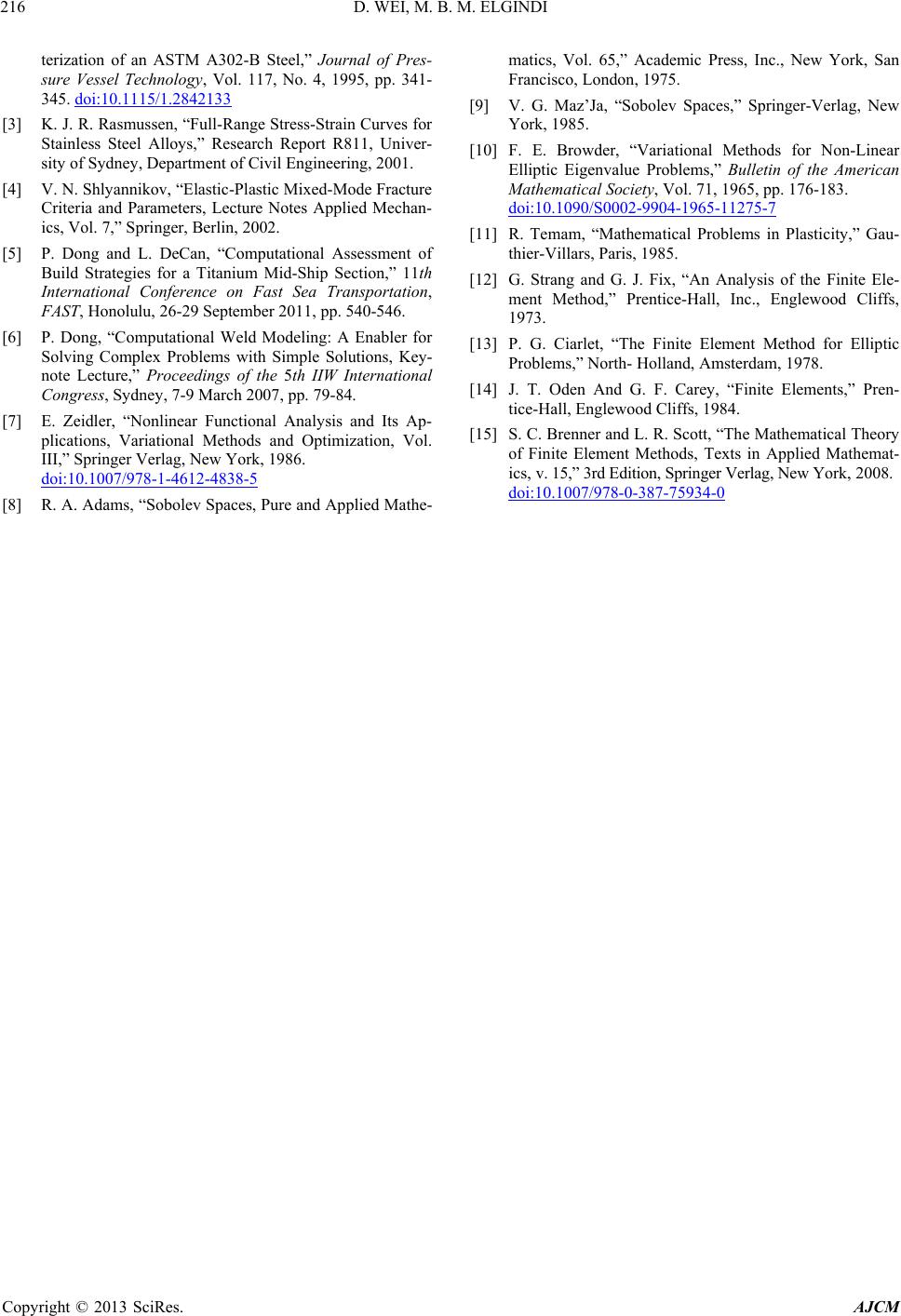 D. WEI, M. B. M. ELGINDI Copyright © 2013 SciRes. AJCM 216 terization of an ASTM A302-B Steel,” Journal of Pres- sure Vessel Technology, Vol. 117, No. 4, 1995, pp. 341- 345. doi:10.1115/1.2842133 [3] K. J. R. Rasmussen, “Full-Range Stress-Strain Curves for Stainless Steel Alloys,” Research Report R811, Univer- sity of Sydney, Department of Civil Engineering, 2001. [4] V. N. Shlyannikov, “Elastic-Plastic Mixed-Mode Fracture Criteria and Parameters, Lecture Notes Applied Mechan- ics, Vol. 7,” Springer, Berlin, 2002. [5] P. Dong and L. DeCan, “Computational Assessment of Build Strategies for a Titanium Mid-Ship Section,” 11th International Conference on Fast Sea Transportation, FAST, Honolulu, 26-29 September 2011, pp. 540-546. [6] P. Dong, “Computational Weld Modeling: A Enabler for Solving Complex Problems with Simple Solutions, Key- note Lecture,” Proceedings of the 5th IIW International Congress, Sydney, 7-9 March 2007, pp. 79-84. [7] E. Zeidler, “Nonlinear Functional Analysis and Its Ap- plications, Variational Methods and Optimization, Vol. III,” Springer Verlag, New York, 1986. doi:10.1007/978-1-4612-4838-5 [8] R. A. Adams, “Sobolev Spaces, Pure and Applied Mathe- matics, Vol. 65,” Academic Press, Inc., New York, San Francisco, London, 1975. [9] V. G. Maz’Ja, “Sobolev Spaces,” Springer-Verlag, New York, 1985. [10] F. E. Browder, “Variational Methods for Non-Linear Elliptic Eigenvalue Problems,” Bulletin of the American Mathematical Society, Vol. 71, 1965, pp. 176-183. doi:10.1090/S0002-9904-1965-11275-7 [11] R. Temam, “Mathematical Problems in Plasticity,” Gau- thier-Villars, Paris, 1985. [12] G. Strang and G. J. Fix, “An Analysis of the Finite Ele- ment Method,” Prentice-Hall, Inc., Englewood Cliffs, 1973. [13] P. G. Ciarlet, “The Finite Element Method for Elliptic Problems,” North- Holland, Amsterdam, 1978. [14] J. T. Oden And G. F. Carey, “Finite Elements,” Pren- tice-Hall, Englewood Cliffs, 1984. [15] S. C. Brenner and L. R. Scott, “The Mathematical Theory of Finite Element Methods, Texts in Applied Mathemat- ics, v. 15,” 3rd Edition, Springer Verlag, New York, 2008. doi:10.1007/978-0-387-75934-0
|